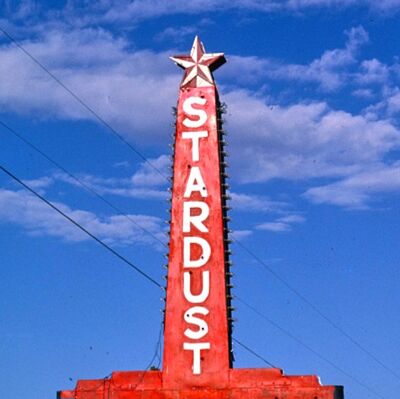Camera write buffer
Jun 25, 2018 09:10:31 #
I have a Canon 6D and while I love the camera when I shoot in continuous mode (6 frames p/sec) I will fill the buffer after 8-12 frames shooting RAW and I have to wait for the camera to write to the SD card. It does seem to be somewhat dependent on shutter speed and aperture but that might just be me. I use the fastest SD cards available but the write speed causes me to miss shots. I have learned to be judicious in how many frames I shoot but sometimes I have no choice. I haven't found a solution to this issue other than a new body. I thought maybe I could upgrade the buffer memory but that doesn't seem to be an option. Any one else have this problem? Maybe a suggestion or solution? BTW I shoot action at rodeos, dog shows, and sporting events thus the need for continuous, high volume shooting.
Thanks...
Thanks...
Jun 25, 2018 09:37:51 #
Unique groupings of technical capabilities targeted for specific needs is one of the many reasons for why each manufacturer has so many similar models of cameras. If you should find only the Apex models from Nikon and Canon have a RAW buffer for your needs, you might consider using JPEG Fine for your bursts rather than RAW. The camera buffer will hold more of these smaller files vs RAW. Given the majority of files created in a burst will the trashed, you might question why you're capturing in RAW if it causes you to miss the keeper shot when capturing in bursts.
Jun 25, 2018 10:03:21 #
CHG_CANON wrote:
Unique groupings of technical capabilities targete... (show quote)
Thank you. That makes sense and I know that smaller files equal more files so I will give that a try. I use RAW primarily because I need to do some extensive cropping and work with lighting and background junk, especially for dog shows and rodeos. These shots usually end up in print magazines for the specific genre so I like to provide the owner with the highest quality I can.
Jun 25, 2018 10:11:17 #
jwest wrote:
Thank you. That makes sense and I know that smaller files equal more files so I will give that a try. I use RAW primarily because I need to do some extensive cropping and work with lighting and background junk, especially for dog shows and rodeos. These shots usually end up in print magazines for the specific genre so I like to provide the owner with the highest quality I can.
I've gone back n forth on JPEG vs RAW at airshows. I've gone back to RAW and have become more judicious on when and how long I start a burst. That may not apply to your situation, but your burst usage might be an area to consider. Also, if you find you're extensively cropping, you might consider whether you're using the correct focal length. The mega megapixels of today's cameras provide a lot of options. But still, for maximum image quality, you should seek to capture the largest image directly onto the sensor rather than cropping to the same result in post.
Jun 25, 2018 10:29:10 #
CHG_CANON wrote:
I've gone back n forth on JPEG vs RAW at airshows.... (show quote)
Good advice and thanks again for your input. The environment I shoot in (especially dog shows) requires a wide enough shot to catch the dog and handler in full motion with enough space around them to present the final product in the proper perspective with leading space. Since I'm panning from across a show ring it is a bit challenging to zoom in any closer. I normally use my 70-200mm f2.8 and you're correct in that I trash all but 1 or 2 out of a dozen or more shots.
Jun 25, 2018 17:02:28 #
It has to do with the size of the files not the shutter speed or aperture setting. Obviously you know your buffer fills and your transfer to SD card can't keep up. Is there a way you can cut down on your bursts to like 3-4 shots at a time versus 6-7-8? That way you can take a shorter bursts, change angle, zoom, whatever, and burst again.
Jun 25, 2018 17:04:30 #
Stardust wrote:
Oops, sorry, see CHG_CANON gave much the same advice - accidentally scrolled by his reply the first time.It has to do with the size of the files not the shutter speed or aperture setting. Obviously you know your buffer fills and your transfer to SD card can't keep up. Is there a way you can cut down on your bursts to like 3-4 shots at a time versus 6-7-8? That way you can take a shorter bursts, change angle, zoom, whatever, and burst again.
Jun 25, 2018 18:18:45 #
Stardust wrote:
It has to do with the size of the files not the shutter speed or aperture setting. Obviously you know your buffer fills and your transfer to SD card can't keep up. Is there a way you can cut down on your bursts to like 3-4 shots at a time versus 6-7-8? That way you can take a shorter bursts, change angle, zoom, whatever, and burst again.
In my case I'm trying to capture a dog's movement at a certain point. I have attached a file showing what owners/handlers want to see. Unfortunately it is mostly luck to get in the right timing with the dog's movement as it takes several feet for the handler to pick up enough speed. I start shooting and panning and if I'm lucky my timing is right & I get the shot. I've tried to watch and time my shot to get the open shoulder and hip but that is very hard to do.
Jun 25, 2018 18:20:26 #
jwest wrote:
In my case I'm trying to capture a dog's movement at a certain point. I have attached a file showing what owners/handlers want to see. Unfortunately it is mostly luck to get in the right timing with the dog's movement as it takes several feet for the handler to pick up enough speed. I start shooting and panning and if I'm lucky my timing is right & I get the shot. I've tried to watch and time my shot to get the open shoulder and hip but that is very hard to do.
Clicked the wrong button. Here is the photo.
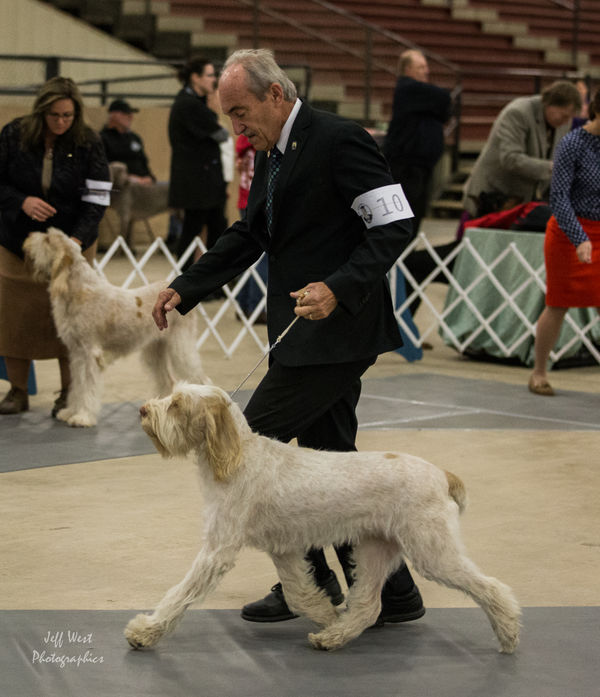
Jun 25, 2018 18:28:25 #
Try renting the 7d mk 2 and see if it solves your problems. I know it is not a full frame but a crop sensor may get you closer and the FPS and great buffer may be a better fit for you.
Jun 25, 2018 18:50:36 #
cmc65 wrote:
Try renting the 7d mk 2 and see if it solves your problems. I know it is not a full frame but a crop sensor may get you closer and the FPS and great buffer may be a better fit for you.
Thank you for the suggestions. I have considered a faster FPS body. In fact, the 7D is on my short list as a crop frame sensor would make sense for me in some other applications. Closer isn't really an issue as I do have a 100-400mm I use when the lighting is good, like in outdoor shows. Indoor shows are at fairgrounds in usually horribly lit buildings so the f2.8 lens is a must.
Jun 25, 2018 23:48:57 #
jwest wrote:
Thank you for the suggestions. I have considered a faster FPS body. In fact, the 7D is on my short list as a crop frame sensor would make sense for me in some other applications. Closer isn't really an issue as I do have a 100-400mm I use when the lighting is good, like in outdoor shows. Indoor shows are at fairgrounds in usually horribly lit buildings so the f2.8 lens is a must.
A couple of comments. If you’re shooting indoors in low light, you’ll find that moving from a 6D to a 7D will have a very noticeable negative effect on noise at the high ISOs you’ll need. At least, go for a 7D MKII or a 5D3. The 7D2 has a substantially higher burst rate than the 6D and a larger buffer (24 or 31 shots with a fastcard), but it will also fill the available buffer more quickly (> 2x the frame rate), so no net gain, and it will be at least a stop worse in terms of high ISO noise. Now, if the crop (1.6x) allows you to use a stop faster lens, then the poorer high ISO performance won’t hurt you as much. For low light action photography, the 5D3 has a much better AF system than the 6D, a faster frame rate (though not as fast as the 7D2), and roughly equivalent high ISO, low noise performance of the 6D, but it has no larger buffer capacity. Of course, the real answer is a IDX MkII, but the price is likely prohibitive.
In terms of maximizing the burst performance of your 6D, first, make sure you are using a memory card with a high write speed (not just the usually specified read speed) - something like the Sandisk Extreme Pro. For a comparison of the max burst capacity of various cards, just Google “fastest memory cards for the Canon 6D”. Second, make sure the in-camera lens correction is turned off and do your corrections in post. Third, try to anticipate shots and reduce your bursts rather than “spray and pray”. Fourth, shoot raw only, not raw+JPEG - that will double the burst from 7 shoots to 14 (or 17 depending on the memory card) before filling the buffer. And finally, as has been mentioned, consider shooting JPEG L instead of raw (personally, that would be my last choice, but if you need to, then it’s an option and will increase your max burst to 78 according to the manual).
Jun 26, 2018 03:07:57 #
While the 6D is an excellent low light camera it's also the budget full frame, not really intended for fast action high speed photography, and yes, I do own one. If I need high speed I use my 7D II or my D500. If I need really high speed I use the 4K video on my 5D IV and do frame captures. The resolution isn't as high but it's equivalent to over 30 fps.
Personally my advice is, get a 7D II and not worry about it not being full frame; you may benefit from the 1.6X crop factor.
Personally my advice is, get a 7D II and not worry about it not being full frame; you may benefit from the 1.6X crop factor.
Jun 26, 2018 15:41:02 #
amfoto1
Loc: San Jose, Calif. USA
jwest wrote:
I have a Canon 6D and while I love the camera when... (show quote)
You must have a 6D Mark II. The original 6D's top continuous shooting rate is 4.5 frame per sec, while the newer model can do 6.5 fps.
The camera's BUFFER is what determines how many consecutive shots it can take at max frame rate, before it needs to pause to clear. The buffer is like RAM in a computer... size matters! So does the speed of the buffer.
Original 6D is rated to be able to buffer about 75 JPEG or 14 RAW. The 6D Mark II has larger images file sizes, but obviously has a bigger, faster buffer because it is rated for 2000 JPEG or 21 RAW.
But it's also important what memory card you're using. This another possible "bottleneck" that can also effect how fast the camera to record data. Cards have different write speeds and more or less advanced technology. For example, the latest SD cards are UHS-I or UHS-II... The 6D Mark II is stated to be compatible with the UHS-I, so that type card, at a minimum, will give best performance (Bryan Carnathan at The Digital Picture tested 6DII with UHS-II and found a slight increase in the number of images AND the continuous shooting rate). The original 6D is not able to take advantage of UHS technology... so SDHC "Class 10" with a high write speed are probably what will let the camera reach it's max potential.
So look closely at the cards you're using... particularly at their write speed. "Read" speed is more important when it comes to downloading images later... but often is a higher figure that manufacturers cite on the cards... You may have to do some research to find out the actual write speed of some cards. If you can't find any info on a particular card's write speed, I'd assume the worst and look at other cards instead.
I hope you have a 6D Mark II, trying to shoot sports and rodeo with it! The 6DII got a much improved AF system: 45-point, all "cross type" points, -3EV and f/8 capable (same system as in 80D and a couple other recent models). The original 6D is a lot less desirable to use for sports/action because of it's slower frame rate, plus it's 11-point AF system, where only the center point is "cross type", -3EV capable, and is "f/5.6 limited" (less useful with some lens/teleconverter combos). Sure, you can take sports/action shots with a 6D, but there are other Canon models able to do the job much better, more easily, and make for more "keepers".
With it's AF system and big bump in frame rates, the 6DII is much more capable than the original for sports/action shooting.
But frankly, shooting similar stuff I deliberately don't use a full frame camera like the 6D-series. A lot of that type of photography is done with telephoto lenses, and an APS-C format DSLR allows you to use considerably smaller, lighter, less expensive lenses. For the last couple years I've been using a pair of 7D Mark II now. (I have a full frame 5D-series camera, but mostly use it for portraiture, landscape, some macro, etc.... almost never for sports). I shot with a pair of original 7D for around five years, previously. Original 7D has a 19-point, all cross type AF system and can shoot at up to 8 fps and buffer 25 RAW. 7DII uses a 65-point, all cross-type AF system, up to 10 fps and buffers 31 RAW. However, a key difference is that the 7D-series use a separate chip to run the AF system, plus dual image processors. This arrangement is much like the 1D-series models use and helps overall performance, but especially focus tracking fast moving subjects. All other Canon use the same single sensor both to run auto focus and to handle images (the 50MP 5DS models use dual image processors).
The faster frame rates and higher performance AF are great, but mainly an APS-C model allows me to shoot hand held with a $1350, 3 lb. 300mm f/4 IS lens instead of a $9000, 8 lb. 500mm f/4 that a full frame camera would require and is pretty much tripod-only (or at least monopod). Similarly, I can hand hold a $1000, 1.65 lb. 135mm f/2 on APS-C versus a $5700, 5.5 lb. 200mm f/2 on FF.... or be more mobile with a $2000, 3.5 lb. 100-400mm on APS-C versus an $11,000, 8 lb. 200-400mm 1.4X Extender that would be needed to frame subjects similarly with a FF camera.
Finally, what are you doing that's filling the buffer? I shoot short bursts at max frame rate... usually no more than 2 or 3, maybe 4 images... only very rarely 5 or 6. I almost never have had to wait for buffer to clear.. even with slower, less capable cameras with smaller buffers and lower performance memory cards.
For some sports I just time individual shots. But I often use short bursts for equestrian sports, in particular, because it's difficult to precisely time horses' strides... They can look awkward frozen in a still shot. For every "keeper" that I'm happy with, there are probably one or two or three I don't care for and trash. It's very rare for me to get series like these:



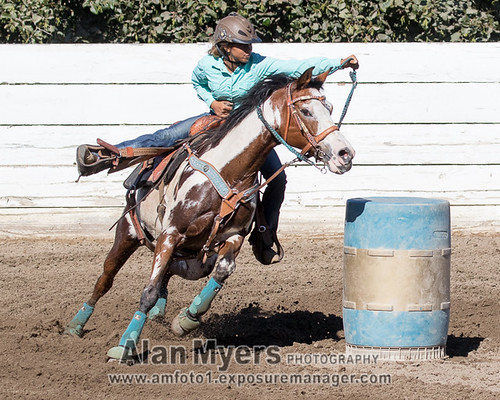
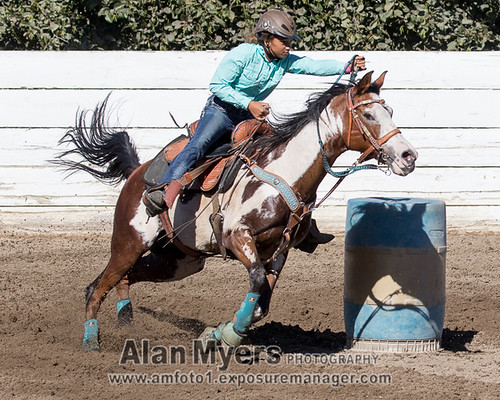
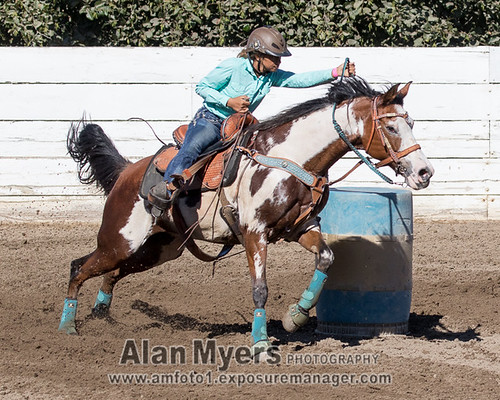




Far more often I take short bursts.... 2 or 3 images... to get a single shot where everyone is posed is "just right":



Another reason I keep to short bursts.... I really hate sitting at my computer editing images any more hours than necessary. Usually it's around 1500 to 2500, but at larger events I may take 4000 or 4500 images in a day. Worst I've done is 6000 images... and over the course or a large, 4-day event around 17,000 images! Even just doing fast proofing in Lightroom... spending 30 seconds or less inspecting & tweaking each image... 1500 images is about 12 hours work.
Jun 26, 2018 20:01:42 #
You simply have the wrong camera for the job at hand. You should get a 7D Mark II, or a 5D Mark IV or a 1DX Mark II. The 7D Mk II is an excellent camera and has a huge buffer for those that like to shoot sports and wildlife. It's also economical and all your Canon lenses will work on it.
jwest wrote:
I have a Canon 6D and while I love the camera when... (show quote)
If you want to reply, then register here. Registration is free and your account is created instantly, so you can post right away.


